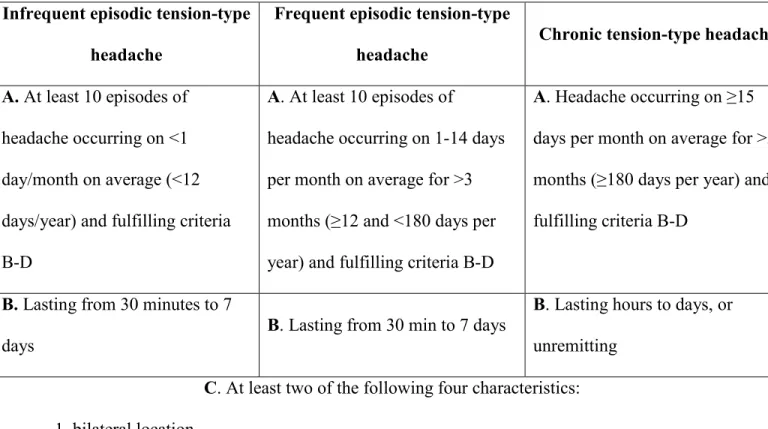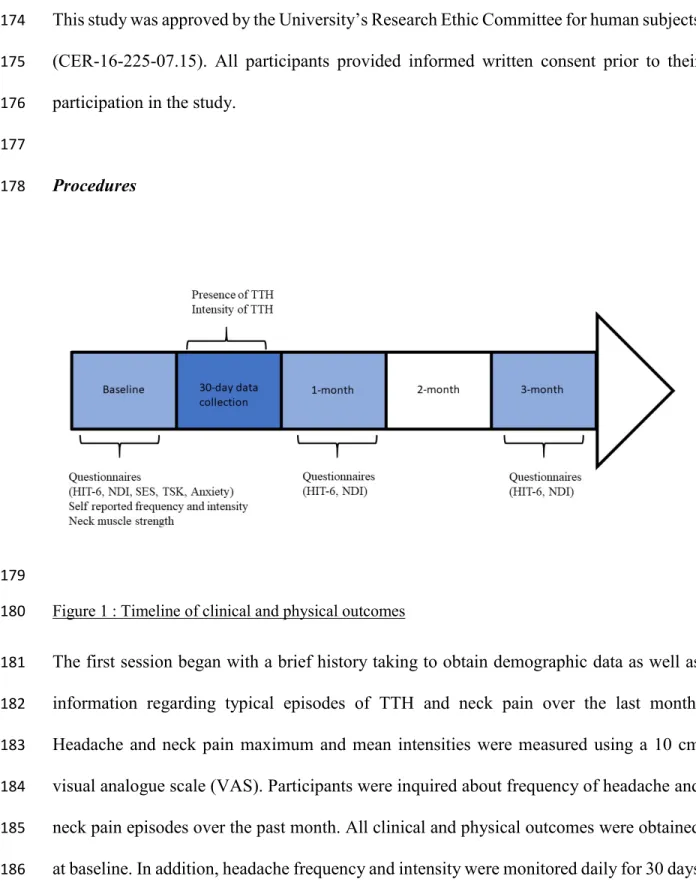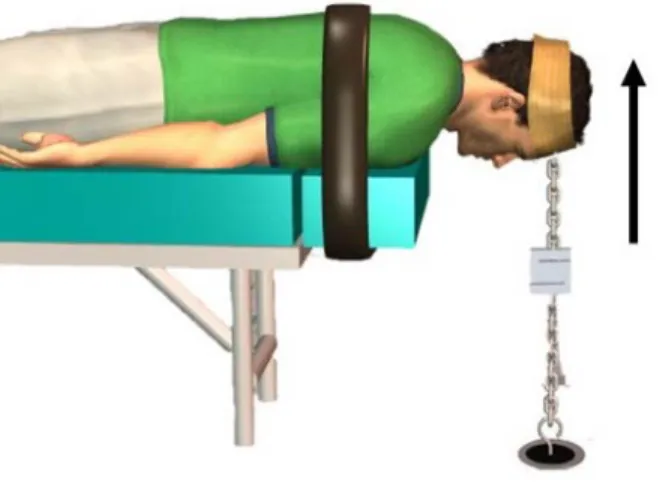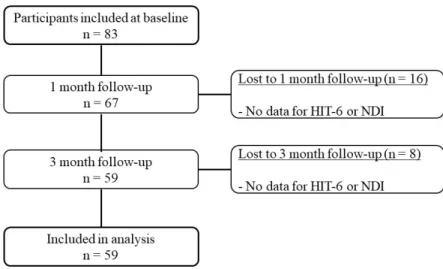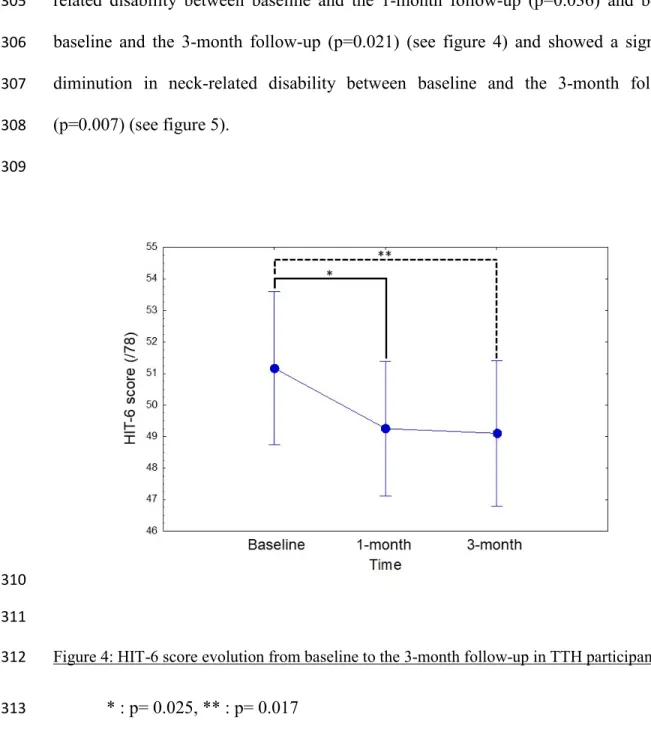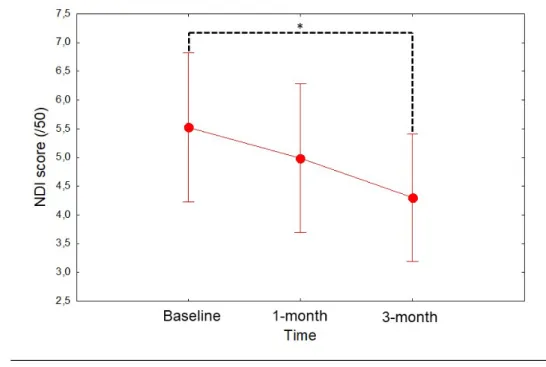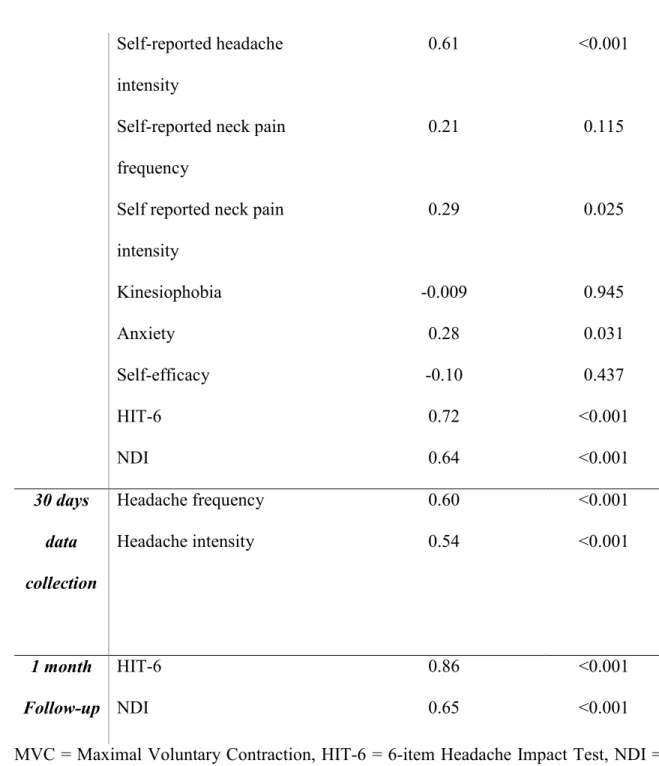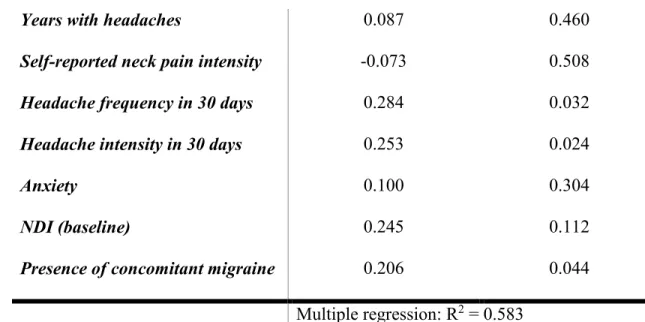Manuscript title: 1
Can headache profile predict future disability: a cohort study. 2 3 Authors informations: 4 5 Mariève Houle, MSc (c) 6
Department of Human Kinetics, Université du Québec à Trois-Rivières 7
3351 Boul. des Forges, Trois-Rivières, Qc G8Z 4M3 8 Phone : (1) 819-376-5011 ext.3798 9 Email: marieve.houle@uqtr.ca 10 11 Andrée-Anne Marchand, PhD 12 Postdoctoral fellow 13
Faculty of Health Sciences, Ontario Tech University 14
2000 Simcoe Street North, Oshawa, ON, L1G 0C5 15 Phone : None 16 andree-anne.marchand@uoit.ca 17 18 19 Martin Descarreaux, PhD 20
Department of Human Kinetics, Université du Québec à Trois-Rivières 21
3351 Boul. des Forges, Trois-Rivières, Qc G8Z 4M3 22 Phone : (1) 819-376-5011 ext.3798 23 Email : martin.descarreaux@uqtr.ca 24 25 26
Conflict of Interest Statement: There is no conflict of interest. 27
28
Funding : This research received no specific grant from any funding agency in the public, 29
commercial, or not-for-profit sectors. 30
Corresponding author: Mariève Houle 31
32
33
34
POSTPRINT VERSION. The final version is published here:
Abstract: 35
Objectives: 36
The aim of this study was to determine if headache profile can predict future disability in 37
patients with TTH. 38
Methods 39
Eighty-three patients with TTH were recruited. To be included in the study participants 40
needed to fulfill the International Headache Society classification’s criteria for episodic or 41
chronic TTH form and to be at least 18 years old. Baseline clinical outcomes (headache 42
and neck-related disability, kinesiophobia, self-efficacy and anxiety) and physical 43
outcomes (neck extensors muscles maximum voluntary contraction) were collected for all 44
patients. A prospective data collection of headache characteristics (intensity and frequency) 45
was conducted using daily SMS or e-mail over a 1-month period. Headache-related 46
disability was assessed at the 3-month follow-up and was used as the disability criterion 47
for TTH. 48
Results 49
Correlations showed that the number of years with headache (r=.53 ; p<0.001 , self-50
reported neck pain intensity (r=.29 ; p=0.025), headache frequency (r=.60 ; p<0.001 ) and 51
intensity (r=.54 ; p<0.001 ), anxiety (r=.28 ; p=0.031) as well as neck-related disability 52
(r=.63 ; p<0.001) were correlated to headache-related disability assessed at 3 months. 53
Multiple regression showed that these determinants can be used to predict headache 54
disability (R2= 0.583). Headache frequency (β=0.284) was the best individual predictor.
55 56 57
Discussion 58
Results showed that TTH frequency and intensity and the presence of concomitant 59
infrequent migraine are predictors of future disability over a 3-month period. Further 60
studies are needed to evaluate the contribution of other potential physical outcomes on 61
headache-related disability. 62
Keys words: Tension-type headache; headache profile; neck pain; disability; strength 63
List of abbreviations 64
TTH: tension-type headache 65
IETTH: infrequent episodic tension-type headache 66
FETTH: frequent episodic tension-type headache 67
CTTH: chronic tension-type headache 68
IHS: International Headache Society 69
MVC: maximum voluntary contraction 70
HIT-6: 6-item headache impact test 71
NDI: neck disability index 72
VAS: visual analogue scale 73 74 75 76 77 78 79 80
Can headache profile predict future disability: a cohort study. 81
Introduction 82
Tension-type headache (TTH) is the most common type of headache [1] with a lifetime 83
prevalence in the general population that ranges between 30% to 78% [2-4]. The average 84
age of TTH onset is estimated between 25 and 30 years old with the peak prevalence for 85
both sexes occurring between 30 to 39 years of age, followed by a decline with increasing 86
age [1, 5]. Women are more affected than men with female:male ratios ranging from 1.3:1 87
to 5:4 [1, 5, 6]. 88
According to the International Headache Society (IHS), tension-type headache is classified 89
as a primary headache [3] and typically described by a bilateral, pressing, tightening and 90
non-pulsating pain. In addition, intensity of TTH is considered to be mild to moderate 91
without aggravation by routine physical activity such as climbing stairs or walking and is 92
not associated with nausea or vomiting except for mild nausea that can be present in chronic 93
TTH (CTTH) [5]. Furthermore, phonophobia or photophobia can occur during TTH 94
episodes, but both symptoms should not be present at the same time [3, 5]. TTH can be 95
divided into two categories: episodic or chronic form. The episodic form is further divided 96
into two subcategories based on the frequency of episodes: infrequent episodic tension-97
type headache (IETTH) or frequent episodic tension-type headache (FETTH) [3]. IETTH 98
is characterized by at least 10 episodes occurring less than one day per month (< 12 days 99
per years), FETTH is characterized by 1 to 14 days per month for at least 3 consecutive 100
months (> 12 and < 180 days per year) and CTTH consists of fifteen days or more with 101
headaches per month (> 180 days per year) [1, 3]. In a Danish population-based study, the 102
one-year prevalence of each category at 40 years old was 48.2%, 33.8% and 2.3% 103
respectively and the prevalence was higher in men for the infrequent episodic TTH than in 104
women but frequent episodic and chronic TTH was more frequent in women than in men 105
[7]. Tension-type headache and particularly CTTH are often associated with medical and 106
psychiatric conditions. Indeed, TTH has previously been linked to common comorbidities 107
such as temporomandibular disorders, depression, anxiety and panic disorders [5]. 108
To date, only a few studies have evaluated risk factors for the development of TTH or risk 109
factors that leads to a transition from episodic to chronic forms [8-10]. In fact, 110
environmental, genetic and peripheral factors such as tenderness in pericranial muscles, 111
muscle strain, muscle blood flow and other central factors have all been hypothesized as 112
possible contributors to the development of TTH [8]. Moreover, risk factors to transition 113
from the episodic TTH form to the chronic TTH form are divided into two categories: non-114
modifiable risk factors and modifiable risk factors. On the one hand, non-modifiable risk 115
factors include increasing age, female sex, being Caucasian, previous history of head 116
trauma and low socioeconomic status [9]. On the other hand, modifiable risk factors 117
include sleep disturbances, medication overuse, obesity and the presence of psychological 118
comorbidities [9]. Depression and anxiety are common with TTH, especially in the chronic 119
form [11]. However, there are only few studies with follow-ups that have been conducted 120
in adults with tension-type headache. A study by Lyngberg and colleagues showed that, in 121
adults randomly drawn from the general population, predictors of poor outcomes in patients 122
with tension-type headache were having frequent episodic or chronic tension-type 123
headache at baseline, having coexisting migraine, not being married and having sleep 124
problems. In their study, no association was found with respect to age, gender or 125
educational levels [12]. 126
Frequency and intensity of tension-type headache are two factors frequently assessed in 127
studies but are also used to define inclusion criteria for TTH participants (IETTH, FETTH 128
or CTTH group). Moreover, Sauro et al. reported a positive correlation between intensity 129
and headache-related disability as evaluated by the 6-item headache impact test (HIT-6) 130
questionnaire but failed to identify any correlations between frequency and headache-131
related disability [13] in patients with headache including patients with TTH. In the general 132
population, individuals with higher impact associated to TTH have a lower quality of life, 133
are more frequently absent from work and have lower work performance [14]. A Danish 134
population-based study reported that absence rates were higher in individuals with FTTH 135
than in healthy subjects [15]. Headache-related disability assessed by the HIT-6 136
questionnaire appear to be an important aspect to monitor in TTH patients to evaluate 137
changes over time and to guide futures clinical interventions. The aim of this study was to 138
determine if headache profile can predict future disability in participants with tension-type 139
headache. 140
141
Materials and Methods 142
Study design 143
This cohort study was conducted at the Laboratory of motor control and neuromechanics 144
located at the University of Québec in Trois-Rivières. Recruitment, testing and follow-up 145
were conducted from August 2016 to November 2017. This study falls within the 146
continuity of a study with controls and TTH participants (Marchand et al. in press in BMJ). 147
148
Participants’ selection 149
Eighty-three participants with tension-type headache were recruited via social media 150
platforms and from the university community. To be included in the study, participants 151
needed to fulfill the International Headache Society (IHS) classification criteria for IETTH, 152
FETTH or CTTH (see table 1). Participants with concomitant headache and neck pain were 153
included only if neck pain was not the dominant pain perceived. For participants 154
experiencing other concomitant headache type, presentation and symptoms of TTH were 155
discussed at baseline and only patients for which tension-type headache was the main 156
headache type were included. Participants with concomitant migraine were included only 157
if their episodes were infrequent. Distinction between headaches types were clearly 158
highlighted at baseline as the goal of the study was to track only information related to 159
TTH over the study period. However, participants were asked to report when they were 160
affected by another headache type during the follow-up period. Exclusion criteria included 161
having a recent history of cervical spine trauma, recent whiplash, neck fracture, surgery or 162
malignant lesion, infection, medication overuse, having a diagnosis of fibromyalgia and 163
having neurological deficits, spasmodic torticollis, presence of upper limb pain or lack of 164
tension type headache episodes. Participants with neck, head or shoulder pain due to an 165
injury were excluded from this study as well as participants with all forms of pain whose 166
frequency and intensity could interfere with headaches. Participants were not allowed to 167
participate if they were under a course of treatment for headache tension-type headache or 168
for neck pain. Pregnant women were also excluded from the experimentation because of 169
the prone position adopted during the neck extension task. 170
Table 1: International Headache Society (IHS) classification criteria for IETTH, FETTH 172
or CTTH 173
Infrequent episodic tension-type headache
Frequent episodic tension-type
headache Chronic tension-type headache A. At least 10 episodes of
headache occurring on <1 day/month on average (<12 days/year) and fulfilling criteria B-D
A. At least 10 episodes of
headache occurring on 1-14 days per month on average for >3 months (≥12 and <180 days per year) and fulfilling criteria B-D
A. Headache occurring on ≥15 days per month on average for >3 months (≥180 days per year) and fulfilling criteria B-D
B. Lasting from 30 minutes to 7
days B. Lasting from 30 min to 7 days
B. Lasting hours to days, or unremitting
C. At least two of the following four characteristics: 1. bilateral location
2. pressing or tightening (non-pulsating) quality 3. mild or moderate intensity
4. not aggravated by routine physical activity such as walking or climbing stairs D. Both of the following:
1. no nausea or vomiting 2. no more than one of
photophobia or phonophobia
D. Both of the following:
1. no nausea or vomiting 2. no more than one of
photophobia or phonophobia
D. Both of the following:
1. no more than one of
photophobia, phonophobia or mild nausea
2. neither moderate or severe nausea nor vomiting
This study was approved by the University’s Research Ethic Committee for human subjects 174
(CER-16-225-07.15). All participants provided informed written consent prior to their 175
participation in the study. 176
177
Procedures 178
179
Figure 1 : Timeline of clinical and physical outcomes 180
The first session began with a brief history taking to obtain demographic data as well as 181
information regarding typical episodes of TTH and neck pain over the last month. 182
Headache and neck pain maximum and mean intensities were measured using a 10 cm 183
visual analogue scale (VAS). Participants were inquired about frequency of headache and 184
neck pain episodes over the past month. All clinical and physical outcomes were obtained 185
at baseline. In addition, headache frequency and intensity were monitored daily for 30 days 186
and two self-reported questionnaires (6-item Headache Impact Test and Neck disability 187
Index) were completed electronically using an online survey at the 1- and 3-month follow-188
ups (see figure 1). 189
190
Clinical Outcomes 191
6-item Headache Impact Test 192
The validated French version of HIT-6 questionnaire was used to assess disability related 193
to headaches [16]. The HIT-6 is a 6-item, retrospective and self-reported questionnaire. 194
This questionnaire addresses several quality of life components of such as pain, cognitive 195
functioning, role functioning, vitality, social functioning and psychological distress [13, 196
17]. Participants were asked to complete the questionnaire based on the past four weeks 197
[13]. The total score obtained was calculated by adding scores from each question for a 198
maximum of 78 points [13]. Higher scores reveal greater headache-related disability. 199
200
Neck Disability Index (NDI) 201
The validated French version of NDI was used to evaluate disability related to neck pain 202
[18]. This is a 10-item questionnaire related to cervical pain and the impact on everyday 203
life as, for example, pain intensity, headache, concentration, reading, driving and work 204
[19]. The total score obtained was calculated by adding scores from each question for a 205
maximum of 50 points and higher scores reveal greater neck-related disability [18]. 206
207
Kinesiophobia, anxiety and self-efficacy 208
At baseline, participants were asked to complete three other questionnaires related to 209
kinesiophobia, anxiety and self-efficacy. Kinesiophobia was assessed using the validated 210
French version of the Tampa Scale of Kinesiophobia (TSK) a 17-items questionnaire which 211
allow to quantify fear of movement with higher score reflecting an increased level of 212
kinesiophobia [20]. To assess anxiety, the validated French-Canadian version of the state 213
trait anxiety inventory (STAI-Y) was used [21]. This 20-item questionnaire allows to 214
evaluate anxiety as a personality trait and anxiety as an emotional state related to a 215
particular situation [21]. Finally, self-efficacy was assessed by the validated French general 216
self-efficacy scale (GSE) which allows the evaluation of individuals perception to meet the 217
needs of tasks in different contexts [22, 23]. 218
219
30-day data collection 220
On a daily basis, participants were asked for 30 days about the presence and intensity of 221
headaches within the last 24 hours. If any, they were invited to identify the type of headache 222
they had (TTH or migraine for participants known to have concomitant types of headache). 223
Based on participants’ preferences, they were contacted by e-mails (5) or text messages 224
(43) and some people (11) preferred to complete a headache diary. 225
226
Physical Outcomes 227
Maximum voluntary contraction (MVC) of neck-extensor muscles was tested in a prone 228
position on a table with the participant’s head and the neck past the edge of the table. To 229
ensure minimal recruitment of thoracic and scapular muscles, the cervico-thoracic junction 230
was stabilized with a strap (see figure 2). To evaluate the strength of the neck extensor 231
muscles, another strap was disposed over the protuberancia occipitalis and was anchored 232
to the floor. The head strap was adjusted to ensure that participants’ head was stabilized in 233
neutral horizontal position throughout testing. Participants were then asked to perform 234
three neck extensors MCV while keeping the neutral horizontal position of the neck and 235
the head. To perform the neck extensors MVC, participants were asked to progressively 236
increase muscle contraction until maximum, hold the maximum for 3 to 5 seconds and then 237
release. Maximum voluntary contractions were recorded using a force gauge (Model 238
IPM250; Futek Advanced Sensor Technology Inc, Irvine, CA, USA). The first trial was 239
performed to familiarized participants with the isometric extension contraction and a 240
further two trials were conducted after the familiarization task. Each trial was followed by 241
a period of rest of one minute. 242
243
244
Figure 2: Participants position during the evaluation of neck extensor maximal isometric strength 245
246
Data and statistical analyses 247
Statistical analyses were performed using STATISTICA statistical package version 10 248
(Statsoft, Tulsa, OK), and the level of significance was set at p<.05. Because of the 249
asymmetrical data distribution (skewness) of several variables, data were normalized 250
whenever it was deemed necessary using log-transformation. Self-reported headache 251
frequency and intensity were compared to the data obtained from the 30-day daily 252
monitoring using dependent t-tests to assess participants’ ability to estimate their headache 253
characteristics. Repeated ANOVA were performed for HIT-6 and NDI questionnaires to 254
assess the evolution of participants’ headache and neck-related disabilities and Tukey post-255
hoc tests were performed to identify significant differences between baseline, the 1-month 256
and the 3-month follow-up for HIT-6 and NDI. Correlations between headache frequency, 257
headache intensity, neck pain frequency, neck pain intensity, kinesiophobia, anxiety, self-258
efficacy, neck-related disability and headache-related disability at the 3-month follow-up 259
were evaluated using the Pearson’s correlation coefficient. Multiple regressions analysis 260
were conducted using the highest correlations value between all determinants and HIT-6 261
questionnaire at the 3-month follow-up to test if any variables predicted future headache-262
related disability over a 3-month period. Significant correlated determinants were added 263
into the stepwise regression model and determinants that significantly contributed to 264
headache-related disability over a 3-month period were identify. 265
266
Results 267
Eighty-three participants were included at baseline. Twelve participants were lost at the 1-268
month follow-up and 8 others were lost at the 3-month follow-up because participants did 269
not return the questionnaires (see figure 3). Before excluding a participant, a reminder was 270
sent on 3 different occasions to any participant who did not return their questionnaires. A 271
total of 59 participants were included in the analysis. Three participants had concomitant 272
infrequent migraine. 273
274
Figure 3: Flowchart of TTH participants enrollment and reasons for exclusion of the 275
analysis 276
Baseline demographics 277
Means scores and standard deviations were calculated for all clinical and physical baseline 278
outcomes (see table 2). Participants presented with low fear of movement (27.80±5.86) and 279
anxiety (35.64±9.47) mean scores and a high self-efficacy mean score (35.42±3.24). The 280
mean score for headache-related disability indicated moderate headache impact (score ≥50 281
points for the HIT-6 questionnaire). 282
283
Table 2: Participant’s baseline results for clinical and physical outcomes 284
Variables Mean SD D em ogr aph ic s Age (years) 27.88 9.41 F:M 40:19 N/A Weight (kg) 67.72 14.12 Height (m) 1.67 0.09 BMI (kg/m2) 24.18 4.10
Years with headache 6.22 6.55
Kinesiophobia (17-68) 27.80 5.86 Self-efficacy scale (10-40) 35.42 3.24 Anxiety (20-80) 35.64 9.47 H eadac he Self-reported frequency of headache (previous month)
6.58 8.06
Self-reported mean intensity of headache (/10) 3.93 1.77 HIT-6 (36-78) 51.17 9.31 N ec k pai n Self-reported frequency of neck pain (previous month)
5.97 8.15
Self-reported mean intensity of neck pain (/10) 2.58 1.89 NDI (/50) 5.52 4.99 St re ng th k MVC (N) 97.57 34.86
SD= standard deviation, F= female, M= male, BMI= body mass index, HIT-6= 6-item 285
headache impact test, NDI= neck disability index, MVC= maximum voluntary contraction. 286
287
Table 3 : Participant’s results regarding frequency and intensity of headache for the 30-day 288 data collection 289 Variables Mean SD Frequency of headache (/30 days) 7.75 6.84 Intensity (/10) 2.97 1.51 290 291
Frequency and intensity of headache 292
T-test for dependent samples comparing self-reported frequency (mean= 6.58; SD = 8.06) 293
and frequency assess at 30 days (7.75; SD= 6.69) revealed no significant difference 294
between self-reported headache frequency and 30 days data collection (p = 0.107). 295
However, there was a significant difference (p < 0.001) between self-reported headache 296
intensity (mean = 3.93; SD = 1.77) and headache intensity obtain from the 30-day data 297
collection (mean = 2.97; SD = 1.51) (see table 2 for self-reported data and table 3 for 30-298
day data collection). 299
300
HIT-6 and NDI score evolution 301
The ANOVA indicated a significant effect of time on headache-related disability (F(2, 302
116)=4.53, p=0.013) and a significant effect of time on neck-related disability (F(2, 303
116)=4.89, p=0.009). Tukey post-hoc test showed a significant decrease in headache-304
related disability between baseline and the 1-month follow-up (p=0.036) and between 305
baseline and the 3-month follow-up (p=0.021) (see figure 4) and showed a significant 306
diminution in neck-related disability between baseline and the 3-month follow-up 307 (p=0.007) (see figure 5). 308 309 310 311
Figure 4: HIT-6 score evolution from baseline to the 3-month follow-up in TTH participants. 312
* : p= 0.025, ** : p= 0.017 313
315
Figure 5 : NDI score evolution from baseline to the 3-month follow-up in TTH participants. 316
* : p=0.007 317
318
Table 4: Correlations between determinants and headache-related disability 319
Variables HIT-6 (3-month)
Correlation coefficient (r)
p
Baseline MVC of neck extensors -0.16 0.236
Years with headache 0.53 <0.001
Self-reported headache frequency
Self-reported headache intensity
0.61 <0.001
Self-reported neck pain frequency
0.21 0.115
Self reported neck pain intensity 0.29 0.025 Kinesiophobia -0.009 0.945 Anxiety 0.28 0.031 Self-efficacy -0.10 0.437 HIT-6 0.72 <0.001 NDI 0.64 <0.001 30 days data collection Headache frequency 0.60 <0.001 Headache intensity 0.54 <0.001 1 month Follow-up HIT-6 0.86 <0.001 NDI 0.65 <0.001
MVC = Maximal Voluntary Contraction, HIT-6 = 6-item Headache Impact Test, NDI = 320
Neck Disability Index 321
322
Table 5: Predictors of headache-related disability 323
Years with headaches 0.087 0.460
Self-reported neck pain intensity -0.073 0.508
Headache frequency in 30 days 0.284 0.032
Headache intensity in 30 days 0.253 0.024
Anxiety 0.100 0.304
NDI (baseline) 0.245 0.112
Presence of concomitant migraine 0.206 0.044
Multiple regression: R2 = 0.583
324
Predictors of headache-related disability at 3 months 325
High correlations were found between self-reported headache frequency, self-reported 326
headache intensity and HIT-6 score at the 3-month follow-up. However, self-reported 327
headache frequency and intensity were excluded from the multiple regression because 328
frequency and intensity were also prospectively collected for 30 days and were considered 329
more specific than self-reported data estimated at baseline considering the past month. Self-330
reported neck pain frequency, kinesiophobia and self-efficacy were also excluded because 331
they did not correlate with HIT-6 at 3 months nor with any other outcome measures (see 332
table 5). Number of years with TTH (r=.53 ; p<0.001), self-reported neck pain intensity 333
(r=.29 ; p=0.025), headache frequency (r=.60 ; p<0.001), headache intensity (r=.54 ; 334
p<0.001), anxiety (r=.28 ;p=0.031) as well as neck-related disability at baseline (r=.64 ; 335
p<0.001) were included in the multiple regression model because of their high correlation 336
with the HIT-6 score at 3 months. Presence of concomitant infrequent migraine was added 337
as a covariable to the multiple regression model given that migraine is known to be a 338
predictor of poor outcome in TTH [12]. Number of years with TTH, self-reported neck 339
pain intensity, anxiety and neck-related disability at baseline were highly correlated with 340
headache-related disability at 3-month. However, in the stepwise regression model, none 341
of them remained significantly associated with headache-related disability at 3-month (p 342
values = 0.460, 0.508, 0.304 and 0.112 respectively). Results showed that headache 343
frequency, headache intensity and the presence of concomitant infrequent migraine were 344
good predictors of headache-related disability at 3 months. All together, predictors were 345
able to predict 58.3 % of the headache-related disability variance. Results of the regression 346
model are presented in table 5. 347
348
Discussion 349
The purpose of this study was to determine if headache profile can predict future disability 350
in participants with TTH. Participants’ mean age was 27.88±9.41 years which is consistent 351
with the age group with the highest TTH prevalence in the literature (25-30 years old). The 352
results showed that 30 days mean headache frequency and intensity as well as self-reported 353
mean intensity of neck pain, years with TTH, neck-related disability and presence of 354
concomitant infrequent migraine can predict future disability in patients with TTH. 355
356
Headaches characteristics 357
With regards to participants’ headache characteristics, the results showed a high correlation 358
between the number of years with TTH and headache-related disability and between 359
number of TTH episodes in a month and headache-related disability as well as a moderate 360
correlation between TTH intensity and headache-related disability. Mild to moderate pain 361
intensity represents the clinical criteria required in the diagnosis of TTH and based on the 362
present results moderate intensity had a higher impact on headache-related disability. In 363
this study, multiple regressions showed that intensity is an important predictor of future 364
disability, but headache frequency was the most important predictive factor of headache-365
related disability. These results are in accordance with a previous study which showed that 366
frequent headache categories (FETTH and CTTH) are associated with higher headache-367
related impact than the infrequent headache category [24]. Kim et al. (2015) also reported 368
an increased burden of headache-related disability associated to the chronic form compared 369
to infrequent and frequent episodic forms [25]. TTH patients seem to be more affected by 370
the number of headache episodes than by their intensity. Suffering from TTH on a regular 371
basis seems to influence psychological well being. In fact, frequent headache and disability 372
seem to impair quality of life [26, 27]. Headache intensity contributes to occasional 373
disability in a month or in a year while a higher number of headaches in a month can 374
contribute to higher disability. A previous study showed the impact of ETTH and CTTH 375
and their contribution to absenteeism and presenteeism in TTH patients [28]. 376
377
Neck pain and neck extensor muscle strength 378
In the current study, neck pain and neck extensor muscle MVC were assessed because neck 379
pain has been traditionally linked with tension type headache [29, 30] and neck pain has 380
been shown to be more prevalent in TTH patients than in individuals with no TTH [31]. 381
Neck pain has previously been associated with decreased neck muscle strength [32, 33]. 382
The present study did not reveal any correlation between neck extensor muscle strength 383
and headache-related disability. In addition, neck muscle strength was not retained among 384
predictive factors of future headache-related disability. However, results showed that 385
concomitant neck pain was present in TTH patients with a self-reported mean of 5.97 days 386
(SD = 8.15) which is consistent with the literature [31]. Results also showed that neck pain 387
intensity was correlated with a higher score in HIT-6 at the 3-month follow-up (r=0.29) 388
and that it can be considered as a predictive determinant of future disability. Ashina et al. 389
(2015) found a correlation between neck pain frequency and the frequency of TTH and 390
suggested a possible shared pathophysiological mechanism between neck pain and primary 391
headache including tension-type headache [31]. Regarding neck extensor muscle strength, 392
previous studies showed a decrease in neck extensor muscle force production in TTH 393
patients compared to healthy controls [33, 34]. However, our results showed that MVC is 394
not a physical determinant of future disability as evaluated by the HIT-6 questionnaire. 395
396
HIT-6 and NDI 397
Findings of the present study indicated statistically significant decreases in headache-398
related disability and neck-related disability over the 3-month follow-up period but these 399
differences were not clinically significant. To be considered clinically significant, the 400
minimally clinical important change in TTH related disability should reach 8 points on the 401
HIT-6 score [17]. The results of the present study showed a decrease of only 2.07 points 402
on the HIT-6 mean score between baseline and the 3-month follow-up. Regarding the neck 403
disability, a difference of 3.5 points on the NDI scale represents the minimally clinical 404
important change [35] and the present results indicated a decrease of 1.21 points between 405
the baseline and 3-month scores therefore not reaching the threshold for neck-related 406
disability minimally clinical important change. The decrease for HIT-6 and NDI scores 407
found in the present study can be explained by the natural fluctuation of tension-type 408
headache over time. Indeed, prognostic factors of TTH recovery are less severe headache,
409
mild headache-related disability, not using medication, absence of anxiety, sleep problem, 410
depression or other pain [36]. 411
412
Kinesiophobia, anxiety and self-efficacy 413
The results showed low levels of kinesiophobia and high self-efficacy scores and these 414
scores were not correlated to any of the clinical or physical outcomes. The current results 415
showed that anxiety was correlated with headache-related disability. Anxiety has been 416
extensively explored in TTH and some studies found that anxiety seemed to be more 417
dependent on the TTH frequency [37, 38] which means that CTTH patients would be more 418
anxious than ETTH patients. Results of the present study are consistent with theses 419 previous findings. 420 421 Limitations 422
This study is not without limitations. Indeed, baseline neck pain frequency and intensity 423
were self-reported by participants based on episodes over the past month, which could have 424
been influenced by recollection bias. Although the comparison between retrospective and 425
prospective self-reported data showed that participants were able to correctly estimate 426
headache frequency, they overestimated headache intensity which could also have been 427
overestimated in self-reported neck pain intensity. In addition, in the present study, TTH 428
participants results were analyzed without considering TTH categories (infrequent 429
episodic, frequent episodic and chronic), and it should be kept in mind that results could 430
differ between the episodic forms and the chronic form. Another limitation is our small 431
number of participants, meaning that the results should be interpreted with caution. 432
433
Results of the present study showed that TTH frequency and intensity, and the presence of 434
concomitant infrequent migraine are predictors of future disability over a 3-month period. 435
Results also showed that neck extensor muscles strength was not correlated with headache-436
related disability or with any other clinical outcomes and was not a good predictor of future 437
disability. Further studies are needed to evaluate the predictive value of other physical 438
outcomes on headache-related disability. Tension-type headache constitutes a major public 439
health problem and a better understanding of clinical and physical factors is needed. Health 440
professionals should consider clinical outcomes to evaluate and elaborate future treatment 441
strategies for patients with TTH. 442
443
Declarations: 444
Ethics approval and consent to participate: This study has been approved by the ethic 445
committee of human subjects of the Université du Québec à Trois-Rivières (CER-16-225-446
07.15). 447
Availability of data and material : The datasets used and/or analysed during the current 448
study are available from the corresponding author on reasonable request. 449
Competing interests : None to declare. 450
References 452
1. Jensen, R.H., Tension-Type Headache - The Normal and Most Prevalent Headache. 453
Headache, 2018. 58(2): p. 339-345. 454
2. Jensen, R. and L.J. Stovner, Epidemiology and comorbidity of headache. Lancet Neurol, 455
2008. 7(4): p. 354-61. 456
3. The International Classification of Headache Disorders, 3rd edition (beta version).
457
Cephalalgia, 2013. 33(9): p. 629-808. 458
4. Rasmussen, B.K., et al., Epidemiology of headache in a general population--a prevalence 459
study. J Clin Epidemiol, 1991. 44(11): p. 1147-57. 460
5. Crystal, S.C. and M.S. Robbins, Epidemiology of tension-type headache. Current pain and 461
headache reports, 2010. 14(6): p. 449-454. 462
6. Schwaiger, J., et al., Prevalence of primary headaches and cranial neuralgias in men and 463
women aged 55-94 years (Bruneck Study). Cephalalgia, 2009. 29(2): p. 179-87. 464
7. Russell, M.B., Tension–type headache in 40–year-olds: a Danish population–based sample 465
of 4000. The journal of headache and pain, 2005. 6(6): p. 441-447. 466
8. Ashina, S., L. Bendtsen, and M. Ashina, Pathophysiology of tension-type headache. Curr 467
Pain Headache Rep, 2005. 9(6): p. 415-22. 468
9. Ashina, S., A. Lyngberg, and R. Jensen, Headache characteristics and chronification of 469
migraine and tension-type headache: A population-based study. Cephalalgia, 2010. 30(8): 470
p. 943-52. 471
10. Hagen, K., et al., Lifestyle factors and risk of migraine and tension-type headache. Follow-472
up data from the Nord-Trondelag Health Surveys 1995-1997 and 2006-2008. Cephalalgia, 473
2018: p. 333102418764888. 474
11. Juang, K.D., et al., Comorbidity of depressive and anxiety disorders in chronic daily 475
headache and its subtypes. Headache, 2000. 40(10): p. 818-23. 476
12. Lyngberg, A.C., et al., Prognosis of migraine and tension-type headache: a population-477
based follow-up study. Neurology, 2005. 65(4): p. 580-5. 478
13. Sauro, K.M., et al., HIT-6 and MIDAS as measures of headache disability in a headache 479
referral population. Headache, 2010. 50(3): p. 383-95. 480
14. Jensen, R., Diagnosis, epidemiology, and impact of tension-type headache. Current pain 481
and headache reports, 2003. 7(6): p. 455-459. 482
15. Lyngberg, A.C., et al., Secular changes in health care utilization and work absence for 483
migraine and tension-type headache: a population based study. Eur J Epidemiol, 2005. 484
20(12): p. 1007-14. 485
16. Magnoux, E., M.A. Freeman, and G. Zlotnik, MIDAS and HIT-6 French translation: reliability 486
and correlation between tests. Cephalalgia, 2008. 28(1): p. 26-34. 487
17. Castien, R.F., et al., Minimal clinically important change on the Headache Impact Test-6 488
questionnaire in patients with chronic tension-type headache. Cephalalgia, 2012. 32(9): p. 489
710-4. 490
18. Wlodyka-Demaille, S., et al., French translation and validation of 3 functional disability 491
scales for neck pain. Arch Phys Med Rehabil, 2002. 83(3): p. 376-82. 492
19. Macdermid, J.C., et al., Measurement properties of the neck disability index: a systematic 493
review. Journal of orthopaedic & sports physical therapy, 2009. 39(5): p. 400-C12. 494
20. French, D.J., et al., Fear of movement/(re)injury in chronic pain: a psychometric 495
assessment of the original English version of the Tampa scale for kinesiophobia (TSK). Pain, 496
2007. 127(1-2): p. 42-51. 497
21. Gauthier J, B.S., Adaptation canadienne française de la forme révisée du State Trait 498
Anxiety Inventory de Spielberger. Rev Can Sci Comport 1993. 25: p. 559–578. 499
22. Scholz, U., et al., Is general self-efficacy a universal construct? Psychometric findings from 500
25 countries. European journal of psychological assessment, 2002. 18(3): p. 242. 501
23. Chen, G., S.M. Gully, and D. Eden, Validation of a new general self-efficacy scale. 502
Organizational research methods, 2001. 4(1): p. 62-83. 503
24. Fumal, A. and J. Schoenen, Tension-type headache: current research and clinical 504
management. The Lancet Neurology, 2008. 7(1): p. 70-83. 505
25. Kim, B.-S., et al., Factors associated with disability and impact of tension-type headache: 506
findings of the Korean headache survey. The Journal of Headache and Pain, 2015. 16(1): 507
p. 40. 508
26. Cassidy, E.M., et al., Factors associated with burden of primary headache in a specialty 509
clinic. Headache, 2003. 43(6): p. 638-44. 510
27. Marcus, D.A., Identification of patients with headache at risk of psychological distress. 511
Headache: The Journal of Head and Face Pain, 2000. 40(5): p. 373-376. 512
28. Robbins, M.S. and R.B. Lipton. The epidemiology of primary headache disorders. in 513
Seminars in neurology. 2010. © Thieme Medical Publishers. 514
29. Marcus, D.A., et al., Musculoskeletal abnormalities in chronic headache: a controlled 515
comparison of headache diagnostic groups. Headache, 1999. 39(1): p. 21-7. 516
30. Sohn, J., et al., Differences in cervical musculoskeletal impairment between episodic and 517
chronic tension-type headache. Cephalalgia, 2010. 30(12): p. 1514-1523. 518
31. Ashina, S., et al., Prevalence of neck pain in migraine and tension-type headache: a 519
population study. Cephalalgia, 2015. 35(3): p. 211-9. 520
32. Scheuer, R. and M. Friedrich, Reliability of isometric strength measurements in trunk and 521
neck region: patients with chronic neck pain compared with pain-free persons. Arch Phys 522
Med Rehabil, 2010. 91(12): p. 1878-83. 523
33. Madsen, B.K., et al., Neck and shoulder muscle strength in patients with tension-type 524
headache: A case-control study. Cephalalgia, 2016. 36(1): p. 29-36. 525
34. Madsen, B.K., et al., Neck/shoulder function in tension-type headache patients and the 526
effect of strength training. J Pain Res, 2018. 11: p. 445-454. 527
35. Pool, J.J., et al., Minimal clinically important change of the Neck Disability Index and the 528
Numerical Rating Scale for patients with neck pain. Spine, 2007. 32(26): p. 3047-3051. 529
36. Boardman, H., et al., The natural history of headache: predictors of onset and recovery. 530
Cephalalgia, 2006. 26(9): p. 1080-1088. 531
37. Peñacoba-Puente, C., et al., Interaction between anxiety, depression, quality of life and 532
clinical parameters in chronic tension-type headache. European Journal of Pain, 2008. 533
12(7): p. 886-894. 534
38. Song, T.-J., et al., Anxiety and depression in tension-type headache: a population-based 535
study. PloS one, 2016. 11(10): p. e0165316. 536
537
538
